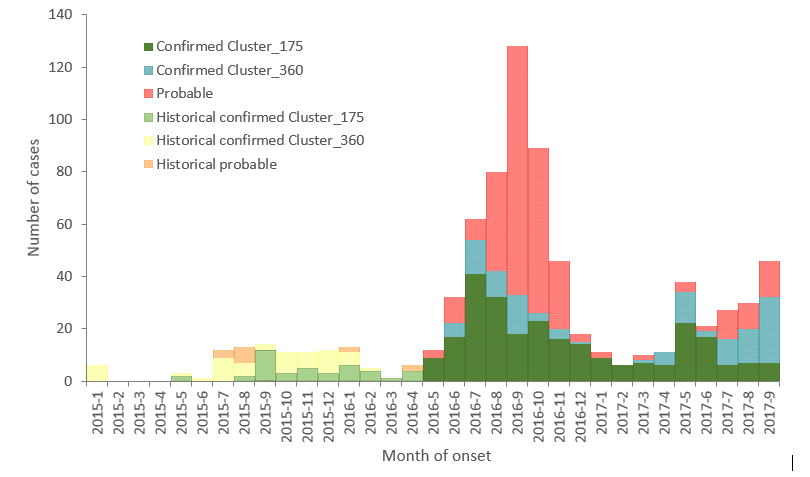Epidemiological update: multi-country outbreak of Salmonella Enteritidis with MLVA profile 2-9-7-3-2 or 2-9-6-3-2 infections
Since the previous ECDC epidemiological update was published on 30 June 2017, seven EU/EEA countries (Belgium, France, Luxembourg, the Netherlands, Norway, Sweden and the United Kingdom) have reported 96 confirmed and 34 probable new cases associated with the multi-country outbreak of Salmonella Enteritidis with MLVA profiles 2-9-7-3-2 or 2-9-6-3-2 ongoing in the EU/EEA. Overall, 797 cases have been found that are associated with this outbreak: 376 confirmed and 291 probable cases since 1 May 2016, and 106 historical-confirmed and 24 historical-probable cases between 2012 and 30 April 2016.
Figure 1. Distribution of cases by month of onset*, case classification and WGS strain (n=775), EU/EEA, January 2015 to September 2017, as of 5 October 2017

The 2016 outbreak investigation identified eggs originating from three Polish packing centres as the vehicle of infection in this outbreak. Following the implementation of control measures in Poland in November 2016, the reporting of new cases fell sharply (Figure 1). However, since March 2017, the number of newly reported cases has increased again, with a peak of 38 cases in May 2017 and a second peak of 46 cases in September 2017. Due to reporting delays, additional cases are expected to be reported with onset in recent months.
Outbreak-confirmed cases belong to two different WGS clusters: Cluster_175 and Cluster_360. As reported in the latest ECDC/EFSA rapid outbreak assessment, these two WGS clusters were also detected during the 2016 environmental and veterinary investigations at the sites producing the vehicles of infection. While most human isolates belonged to Cluster_175 between January and June 2017, isolates belonging to the Cluster_360 have been more frequently reported since July 2017. As of 5 October 2017, most of the 200 outbreak cases (155 confirmed and 45 probable cases) identified with onset from January to September 2017 were reported by the United Kingdom (135 confirmed and three probable cases) (Figure 2). It should however be noted that the United Kingdom is the only country performing routine and close to comprehensive WGS-based typing of Salmonella. Thus, the number of cases associated with this outbreak reported by other EU/EEA countries is most likely underestimated.
Figure 2. Outbreak cases by month of onset* and reporting country (n=775), EU/EEA, January 2015 to September 2017, as of 5 October 2017

Of the 35 cases probably infected outside their country of residence since 1 July 2017, 24 cases had a travel history to Bulgaria (six confirmed and six probable) or to Greece (two confirmed and ten probable). Additional cases were reported to have travelled to Poland (three probable cases), Spain (one confirmed and two probable cases), Italy (one confirmed case), Portugal (one confirmed case) and Romania (one confirmed case). Two probable cases had a travel history to multiple EU countries. The single case with a travel history to Bulgaria reported before July 2017 had onset in June 2017: it is therefore plausible that Bulgaria has only been affected by this outbreak in recent months.
Assessment
As reported in the latest ECDC/EFSA rapid outbreak assessment, evidence from epidemiological, microbiological, environmental and tracing investigations identified eggs originating from Poland as the vehicle of infections in this outbreak in 2016. The re-emergence of cases infected with the outbreak strains since March 2017 is currently under investigation. It is likely that more countries are affected by the outbreak, but that they have not been detected because molecular typing is not performed routinely for human S. Enteritidis isolates.
Actions
Further investigations are required to identify the origin of the transmission to control this outbreak. ECDC is continuing to monitor the occurrence of human cases associated with this threat and offering sequencing services for countries reporting probable cases of human S. Enteritidis isolates with MLVA profile 2-9-7-3-2 or 2-9-6-3-2. EU/EEA countries should consider interviewing new outbreak-confirmed cases.
Disease page
Salmonellosis
Enteric infections due to Salmonella bacteria are generally referred to by the term ‘salmonellosis’ when they are due to Salmonella species other than Salmonella typhi and Salmonella paratyphi.
Risk assessment
Rapid outbreak assessment: multi-country outbreak of Salmonella Enteritidis phage type 8, MLVA profile 2-9-7-3-2 and 2-9-6-3-2 infections, 7 March 2017
An outbreak of S. Enteritidis phage type 8 is ongoing in the EU/EEA. Isolates are part of two distinct but related genetic clusters. ECDC and EFSA are liaising with relevant authorities to facilitate the coordination of investigation response measures.




